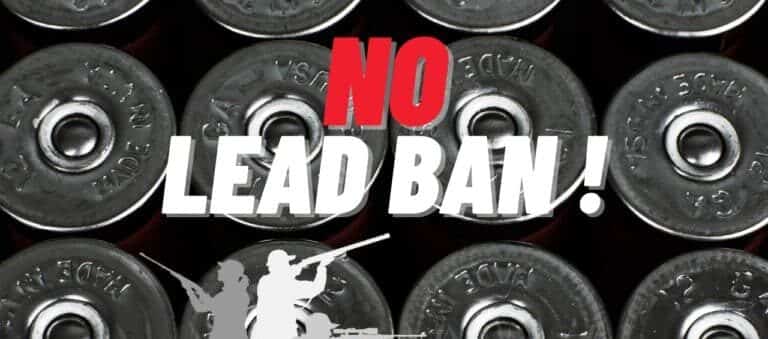OPPOSE THE BIDEN ADMINISTRATION’S ATTEMPT TO BAN LEAD AMMUNITION ON FEDERAL LANDS
Gun Owners of America works diligently to protect the Second Amendment Rights of American citizens, and we are also standing on the front lines to protect the American hunting tradition.
A recent announcement by the U.S. Fish and Wildlife Service (USFWS), which operates within the U.S. Department of the Interior, should be of concern to all hunters, recreational shooters, and Second Amendment advocates.
According to the Federal Register, the USFWS proposes to ban the use of lead ammunition and fishing tackle on certain federal lands by 2026. This ban on federal lands may well be a precursor to more widespread bans across the country.
Please Contact the U.S. Department of the Interior and Oppose the Lead Ammunition Ban!
The USFWS, in its own words, states, “Finally, the best available science, analyzed as part of this proposed rulemaking, indicates that lead ammunition and tackle may have negative impacts on both wildlife and human health…..”.
The use of the word “may” rather than “does” should tell us what we need to know about the uncertain science backing up this decision.
It is no secret that many on the Anti-gun Left want to ban lead ammunition. In 2014, the U.S. District Court of Appeals dismissed an effort by anti-hunting groups to ban traditional lead ammunition and announced that the Environmental Protection Agency (EPA) “lacked statutory authority to regulate bullets and shot” under the Toxic Substances Control Act.
However, anti-gun and anti-hunting groups did not give up!
WHAT IS REALING HAPPENING is the Biden administration is caving to demands from the Center for Biological Diversity (CBD) to ban lead ammunition because these groups are opposed to the American traditions of hunting and recreational shooting.
Let’s look at some facts.
EFFECTS ON PEOPLE
In 2008, the U.S. Centers for Disease Control and the North Dakota Health Department issued a joint study assessing the blood levels of participants who consumed and did not consume meat from wild game.
This study showed that the participants who ate wild game had a very slightly higher lead blood level compared to people who did not consume wild game. However, that number was not statistically significant, meaning it did not show a real scientific effect. A similar study by the Wisconsin Department of Health and Human Services showed lead poisoning doesn’t result “from ingestion of lead bullet fragments in large game animals.” In other words, the lead is coming from other environmental sources besides ammunition.
EFFECTS ON WILD ANIMALS
The problem we face is that those who want to ban lead ammunition make the misguided assertion that the use of lead ammunition in hunting causes lead poisoning in wildlife species across widespread areas.
However, the science they present to support their allegations is suspect.
Many studies on the impacts of lead from hunting have involved questionable sample sizes, cherry-picked data to incriminate lead ammunition, and the exclusion of unfavorable data that contradicts an anti-lead hypothesis.
Some researchers have even been sued in court for withholding “original” data that might contradict an anti-lead ammunition position.
As activist researchers manipulate the scientific process to find evidence against lead ammunition, they often ignore the presence of numerous non-ammunition lead sources that are common in the environment. These sources can include such items as lead-based paint, gasoline, pesticides, galvanized screws, nuts, bolts, washers, and many other items.
All of the aforementioned items have been shown to be available and attractive to California condors. Condors are a species often pointed to by anti-lead advocates as threatened by lead because condors feed on the carcasses of harvested big game animals. These non-ammunition items containing lead have appeared in condor nests, their digestive tracts, and in the digestive tracts of their fledglings.
Activists and researchers advocating for lead bans consistently overlook such alternative environmental sources.
In 2007, California passed legislation when supporters claimed that condors were being poisoned by lead ammunition, and these proponents assured the public that poisoning would stop if hunters stopped using lead ammunition. Fifteen years later, California Department of Fish and Wildlife’s records show a 99% compliance rate by hunters with the lead ammunition ban. However, the incidence of lead exposure and poisoning in condors remains static and has even increased slightly since the lead-banning legislation went into effect.
California’s lead ammunition ban has been a colossal failure and proves that alternative sources of lead poisoning cannot be ignored.
Every year, new science emerges that suggests a connection between lead poisoning in wildlife and alternative sources of lead in the environment. In short, we just don’t have strong evidence to prove that lead ammunition is harming wildlife because there are so many lead sources in our ecosystems.
ECONOMIC IMPACT
After California’s ban on lead ammunition for hunting, Southwick Associates determined the lead ban was expected to force over 36 percent of licensed hunters to stop hunting. Of course, this also helps to further the goal of every anti-gunner in the gun-ban movement. They want to demonize firearms and discourage as many Americans as possible from learning to use and enjoy firearms, as protected under the Second Amendment.
Europe faces a lead ban throughout all European Union Countries. Studies by the European Shooting Sports Forum and the European Federation for Hunting and Conservation suggest 25% of hunters would stop hunting outright, and over 30% of all European hunters would drastically reduce their activities, under a complete lead ammunition ban.
America’s Centuries Old Hunting Tradition Will Suffer if Lead Ammunition is Banned
In America, according to some sources, a complete switch from lead ammunition would result in 30,000 people losing their jobs and a $4.9 billion hit to the United States Gross Domestic Product. Further, we could expect drastic ammunition price increases followed by ammunition shortages. Some studies have suggested 10-20 times increases in ammunition costs due to a lead ban.
CLOSING
While the impacts of lead on humans and wildlife should continue to be studied, there is little scientific evidence to suggest a widespread lead ban is necessary or justified.
Because of a lack of strong scientific evidence to support a lead ban and the disastrous consequences of such action, the federal government has no scientific justification to ban lead ammunition at this time.
Please contact the U.S. Department of the Interior. Tell them you are writing to oppose the National Lead Ammunition Ban proposed by the U.S. Fish and Wildlife Service.
You can click here to oppose the ban in an official comment .
You can also submit a formal comment to the Federal Register about this proposed rule here.
Mark Jones
Certified Wildlife Biologist®
National Director, Hunter Outreach








